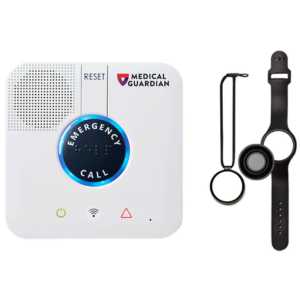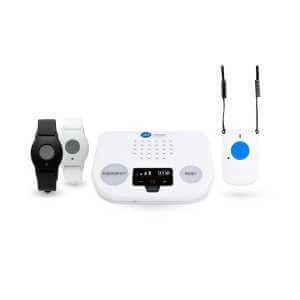Medical alert systems can be described by where they’re used (in-home or on the go) and by whom you talk to through the device (a professional monitoring center, a friend, or 911). We’ll break down the terminology so you can choose the system that’s right for you.
Types of Medical Alert Systems and How They Work
SafeWise experts have years of firsthand experience testing the products we recommend. Learn how we test and review.
By signing up, you agree to our Terms and Conditions and Privacy Policy.
What’s a medical alert system and how does it work?
A medical alert system provides you with a button you can push for assistance during an emergency. The help button is usually worn as a pendant or wristband, but you can also place buttons on the walls throughout your home.
A call is placed to a family member, 911, or professional monitoring center within about 30 seconds of pushing a medical alert button. The system's base station or the button itself has a speaker and microphone to facilitate the conversation.
Don't worry if you can't think or speak during your emergency—the person on the other end of the phone takes that a sign that you need immediate help. They'll dispatch someone to your home or GPS location, depending on the type of device you're wearing.
How medical alert systems work: Video
Subscribe to our YouTube channel for more videos like this one! Learn how to protect your home, your loved ones, yourself and your belongings.
What are the different types of medical alert systems?
Medical alert systems tend to fall into a few overlapping categories. They can be monitored or unmonitored, at-home or wearable. Each comes with its own share of advantages and disadvantages.
In-home medical alert systems
These types of systems center around a base station with a speakerphone and a help button. Just like the name suggests, they're designed to stay stationary in a central location of the home.
Many in-home systems have a range limit, so users in larger homes may need accessories like additional buttons or wearables to place around the house.
Landline vs. cellular in-home alert systems
In-home medical alert systems use either a landline or cellular connection to place calls when the button is pressed.
- Landline medical alert systems are more affordable than cellular systems and more reliable in remote areas.
- Cellular in-home medical alerts are a little more expensive but usually pair with more accessories, like wall buttons and extra pendants, compared to landline systems.
Mobile medical alert systems
Mobile medical alert systems use a cellular connection and battery, allowing users to move independently outside the home. This makes them ideal for seniors who leave the house alone regularly.
Since mobile medical alerts run on batteries, they may need regular charging to keep them working. Many of these systems include GPS tracking technology to help the monitoring center send help in an emergency and keep caregivers updated on whereabouts.
Types of mobile medical alerts
Here are the most common types of mobile medical alert systems (also called GPS medical alerts):
- Pocket base stations pair with the same necklace or wristband button that you'd wear around your home. The speaker and microphone are in the base station, so don't forget to grab it before you head out the door.
- All-in-one mobile medical alert devices are worn on a lanyard or belt clip. They're lightweight and let you keep track of just one device.
- Medical alert smartwatches include two-way talk and a help button. They're discreet, modern, and usually offer some extra functions like fitness-tracking apps. It's tough to find fall detection in medical alert watches, though.
- Bluetooth medical alerts use your smartphone to make phone calls once the help button is pressed. They have a long battery life (months at a time) but you have to keep your phone charged up and nearby at all times.
Looking for a medical alert device?
How does a monitored medical alert system work?
Monitored medical alert systems link to an emergency call center where professionals can speak to you through the base unit or wearable device. The people you speak to on the other side are available 24/7, so there's always someone ready to send for help from EMS or your contacts.
But it costs money to keep all these professionals on-call, so monitored medical alert systems require a monthly fee. Your subscription may include additional perks, such as free spouse coverage, medication alerts, daily check-in calls, and replacement batteries.
How does an unmonitored medical alert system work?
Unmonitored devices look and work just like monitored systems. But instead of a staff of professionals on the line, the emergency call buttons connect to your own emergency contacts who you pre-program into the system.
While there's no monthly fee attached to these types of systems, they also come with a little more risk.
Which is better, monitored or unmonitored?
We recommend choosing a monitored system.
If your unmonitored system is set up to call a family member, there’s a chance they won’t recognize the number or hear their phone go off. When your device is connected to a professional monitoring center, your call will be answered in seconds, guaranteed.
If your device is set up to call 911, you may not feel well enough to talk to them. The monitoring center keeps a record of your home address along with details about your medical history and the code to get into your spare key lockbox.
If you use a GPS-enabled mobile device, your precise location also transmits to the monitoring center. They can relay all of this information to the emergency responders who won’t waste any time trying to find you or get into your home.
Why can’t I just use my phone?
It’s much easier to push a button than it is to pick up a phone and dial the correct number, especially if your medical emergency leaves you feeling confused or weak.
Plus, a medical alert button is waterproof, so you can wear it in the shower. You definitely can’t do that with your phone.
Why can’t I just tell Google Assistant or Amazon Alexa to dial 911?
These smart hubs can’t call 911 on your behalf, at least not through a voice cue. However, new tech like Alexa Together and Lively's Echo integration make it possible to get help from family members or professional monitors by activating a voice hub.
If your medical emergency makes it difficult to breathe, you won't be able to use a voice-activated device. Plus, the smart hub may not hear you depending on where you are in your home. A wearable button keeps help within reach at all times.
Still, a voice-controlled medical alert system is a great back-up option in case you experience poor mobility. Try a medical alert company like Medical Guardian or GetSafe if you’re interested in this type of equipment.
Compare the top 5 best medical alert systems
Data effective as of post date. Offers and availability subject to change.
$19.95 Medical Alert starting price for landline in-home system with annual plan paid up front. Month-to-month plans start at $27.95/mo.
What’s a personal emergency response system?
A personal emergency response system (PERS) is another name for a medical alert system. The name difference recognizes that not all emergencies are medical in nature. A PERS could be used by someone who feels unsafe walking home, for example.
Sources
- Falin Wu, International Journal of Telemedicine and Applications, “Development of a Wearable-Sensor-Based Fall Detection System,” 2015. Accessed November 29, 2022.
Recent Articles










